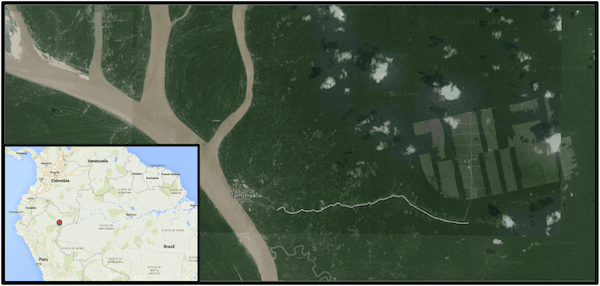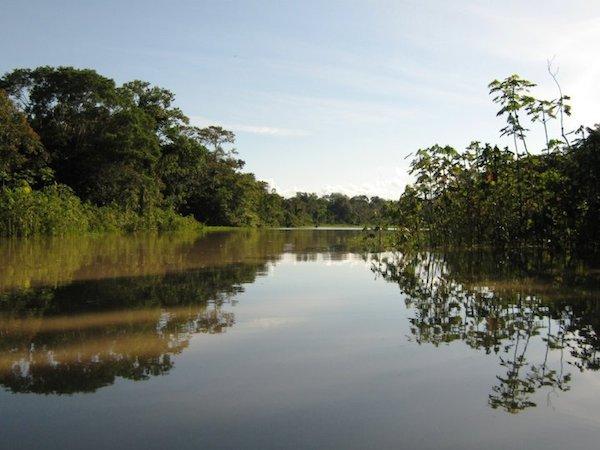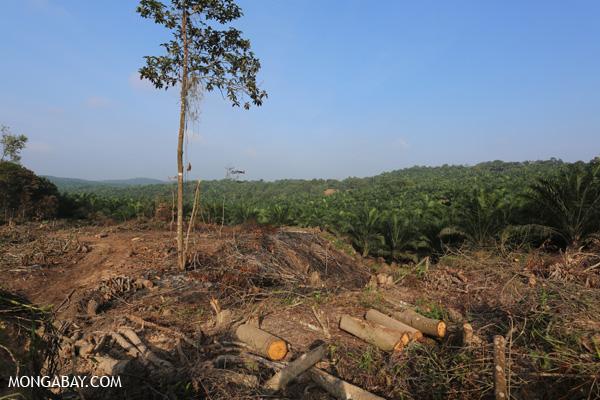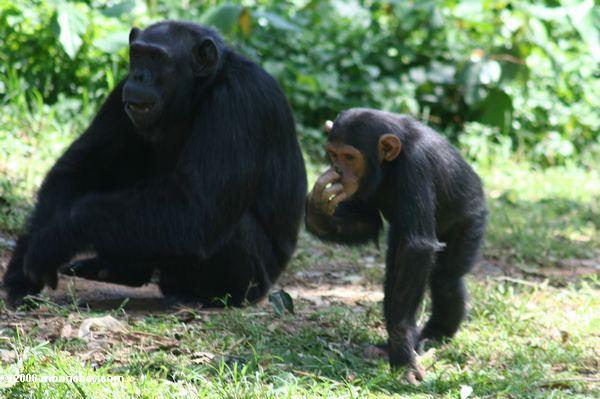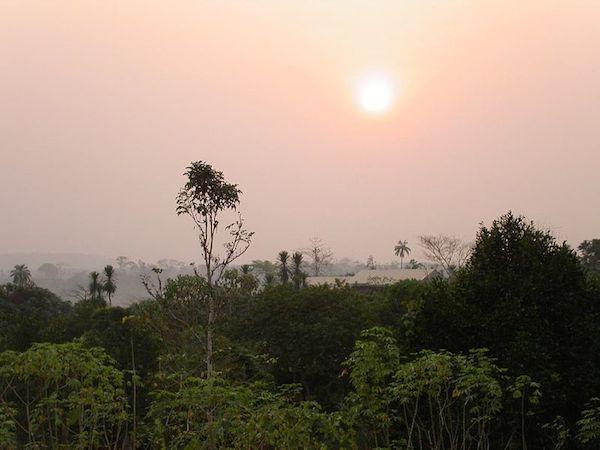A cacao grower with roots in Southeast Asia’s palm oil industry has set up shop in the Peruvian Amazon. The CEO of United Cacao has told the international press that he wants to change the industry for the better, and Peru seems to provide the right conditions and climate, both for the plants themselves and the business.
But a cadre of scientists and conservation groups charge that United Cacao, through its “wholly owned” subsidiary in Peru, Cacao del Peru Norte, has quietly cut down more than 2,000 hectares of primary, closed-canopy rainforest near Iquitos, a city of about half a million that has the distinction of being the largest city in the world that’s not accessible by road.
Tipped off to some unusual deforestation occurring just kilometers from the Amazon River headwaters in the Region of Loreto in Peru, a team of scientists led by ecologist Matt Finer of the Amazon Conservation Association set out to document the destruction in 2013.
“We then watched in pretty much real time from June to October this deforestation unfolding using the Landsat imagery…blow by blow, basically watched it before our eyes,” Finer told mongabay.com. Landsat satellites monitor the earth’s surface and provide data about how it changes over time. As United Cacao began planting at the site, Finer and his colleagues watched the cleared area start to turn green again, around the same time that United Cacao began planting in November 2013.
Clearing the land
That some sort of clearing occurred, as well as who was responsible for it, is not in doubt. In its own financial documents and on its website, United Cacao tells investors that, in May 2013, the company and its partners began “clearing and infrastructure work” to ready the land that it had purchased earlier in the year from local farmers for a cacao plantation.
United Cacao maintains, however, that this area had been used for farming since the late 1990s, and thus it was not primary forest. “Before they bought the land, there was agriculture,” said Ed Portman, a spokesperson for United Cacao. “There was no high-conservation-value forest on that land.” Furthermore, the company argues on its website that the land was “heavily logged of all tropical hardwoods in the 1980s.”
That’s debatable, said Finer. Based on Landsat imagery from 1985, in addition to original analysis by Finer and his colleagues from 1989 to the present, he explained that the area was “certainly not heavily logged or clear cut” and “was still very much intact, closed-canopy forest at that time.” Finer added, “Although the area, like much of the Amazon, may have been selectively logged at some point, we still consider it primary forest based on the imagery.”
Farmland or primary forest?
The state of the forest in the 1980s and 1990s has a bearing on how the land is used in 2015 because “appropriate” best practices and Peruvian law – compliance with both of which United Cacao contends it has “sought to ensure” – that pertain to industrial agriculture aim to protect standing rainforest and favor the use of land that has already been farmed or otherwise degraded.
In addition to logging that United Cacao said occurred in the 1980s, the company argues that a Peruvian law paved the way for the development of its cacao plantation. Legislative Decree 838 passed in 1997 allowed the Ministry of Agriculture to give parts of the Amazon, including the land that United Cacao now owns, to victims of economic depression or terrorist violence. The company’s website states “original inspection documents” from 1997 show that the land in question was used for farming.
According to United Cacao, these original titleholders were free to sell this land, as they have over the past several years to United Cacao, which hopes to consolidate an area that will grow to 4,000 hectares by 2015. United Cacao’s website also states that Decree 838 “provides for immediate and full agricultural development,” which is why Cacao del Peru Norte began developing the land in May of 2013 without conducting an environmental impact assessment – or EIA, for short.
Incidentally, United Cacao tells investors on its website that, “Cacao grows best in areas with natural organic material with some degree of secondary ground cover; pasture land or compacted soils are not suitable.” It’s not certain whether the compaction to which the company is referring would result from the type of farming that they contend has occurred on the land for almost two decades. However, according to the Food and Agriculture Organization of the United Nations, soil compaction can be a serious side effect of agricultural land degradation.
The company does admit that they were only notified of this “agricultural classification” of the land months later in November 2013, after 2,000 hectares of forest had already been cleared, based on Finer’s Landsat imagery analyses.
Further contributing to the legal ambiguity of United Cacao’s activities on the plantation site is a Peruvian law that was passed in November 2012, before the company first acquired the land from the original landowners. As reported in one of United Cacao’s financial documents, this law states, “land owners intending to develop agricultural activities are required to prepare an EIA, which has to be approved by the General Directorate of Environmental Affairs of the Ministry of Agriculture prior to the development of any such activities.”
Why the company chose to prepare the site before being notified of the agricultural classification and do so without an EIA is unclear. After mongabay.com’s conversation with Ed Portman on December 19, 2014, repeated requests for further explanation have gone unanswered.
The Ministry of Agriculture later passed a resolution asserting that, based on the predicates laid out in Decree 838, United Cacao’s activities on the plantation site “were an extension of those initially developed by the original owners in 1997, albeit that they were more intensive,” according to the company’s stock exchange admission document.
Later, the same document continues: “The Group’s position is that no authorisation was required given the land was transferred free of restrictions and even if it was…agricultural activities had previously been carried out on the land by the former owners.”
The Ministry of Agriculture resolution allowed the company to continue its development of the plantation site while carrying out an expedited assessment of the impacts, based on “the extensive agricultural activities previously underway,” according to United Cacao.
But scientific evidence indicates that there was no farming on the land, extensive or otherwise.
Scientific evidence
“According to our time series analysis of Landsat imagery dating back to 1989, nearly 98 percent was closed-canopy” – that is, primary – “forest when the recent clearing began,” Finer said.
Greg Asner, an ecologist at the Carnegie Institution for Science at Stanford University, added that, “Forest cover of greater than 90 percent is not agriculture of any kind.” Asner and his team did their own analysis of the plantation site before and after United Cacao’s development.
But instead of looking at tree cover using satellite imagery, Asner used data gathered from an airplane that employed a combination of a laser-based technology called LiDAR to measure the landscape in three dimensions and an instrument called an imaging spectrometer to determine the chemical makeup of plants in the specific area.
They found that the forest on the plantation site contained an average of more than 122 metric tons of carbon per hectare before it was cleared. “These carbon stock values are found only in intact tropical forest in the region, and are among the highest values mapped within Peru during the joint Carnegie-Peruvian Ministry of Environment carbon mapping project,” Asner wrote in an email to mongabay.com. “The logical conclusion from the scientific data is that large-statured, intact forest was removed by this deforestation event.”
Using two different measures of forest density, Finer and Asner arrived at the same conclusion: primary rainforest in the Amazon was cut down to make way for this cacao plantation.
Data from Global Forest Watch also bolsters the case that deforestation occurred during the time period in question. It uses a monitoring system called Terra-i that issues monthly alerts based on satellite data that identify “deforestation hotspots” at a resolution of 250 by 250 meters. Terra-i alerts began appearing in August 2013, when Finer’s analysis shows 1,000 hectares of land had been cleared at the site.
Questions of legality
Even if agriculture had been occurring on the land, the Ministry of Agriculture’s interpretation of Legislative Decree 838 is not consistent with the law’s intent, according to the Peruvian Society for Ecological Development (SPDE), a conservation group that works in the Amazon. In a letter to the U.S. trade representative regarding the terms of the United States-Peru Trade Promotion Agreement, SPDE Executive Director Lucila Pautrat argued that Decree 838 made land available “with exceptional and temporary basis to displaced individuals, not private companies.”
What’s more, Pautrat writes that Decree 838 was repealed by another law passed in 2010, so in effect, United Cacao and the Ministry of Agriculture are trying “to validate the application of a rule which since 2010 is not part of the current legal system of the country.”
Whether United Cacao was aware that Decree 838 had been rescinded is unclear. Again, the company did not respond to repeated requests from mongabay.com for further explanation. Cacao del Peru Norte, as well as two former employees and one current employee of United Cacao’s group of companies in Peru, have been investigated for three possible offenses: “the commission of crimes against the forest or wood formations, illegal trading of forest wood products, and obstruction of proceedings.”
United Cacao reported that the first charge was found by the Fourth Penal Court on Preliminary Investigations not to “have criminal relevance.” The inquiry, based on the remaining two charges, was supposed to have concluded by the end of 2014, after which time the Environmental District Attorney of Loreto and Maynas would decide whether to file a criminal case, which in turn could lead to a formal trial.
“Serial plantations entrepreneur”
Questions about the legality of United Cacao’s operations run counter to the company’s portrayal of itself as a force for positive change in the industry. On United Cacao’s website, Dennis Melka, CEO of United Cacao, references the company’s goal “of becoming the largest and lowest cost corporate grower of sustainable and traceable cacao beans.”
A Czech citizen and resident of the Cayman Islands, Melka built his reputation in the palm oil industry as a “serial plantations entrepreneur,” according to an article by agrimoney.com, and he’s proven he can make money for his investors. Asian Plantations, a palm oil company that he cofounded, sold in late 2014 for £110 million ($167 million), up from a 2009 market value of £20 million ($30 million).
The rising cost of cocoa could mean even healthier profit margins for United Cacao and other companies looking to meet the 100,000-metric-ton shortfall expected in 2015, reported Bloomberg News on January 7. A metric ton of cocoa for March delivery is now going for nearly $3,000, and last year’s average was up 25 percent compared to 2013. “We’re rushing to plant because it’s an incredible price,” Melka told Bloomberg News.
Investors in United Cacao have high expectations, as well. The initial public offering on December 2, 2014, on the London Stock Exchange’s AIM market for smaller companies helped the company raise more than $10 million to finance expansion. As of January 13, the stock’s price is up 22 percent. United Cacao also hopes to list the company on the Lima Stock Exchange by the middle of 2015.
Melka told the Telegraph newspaper that United Cacao hopes to offer an alternative to the governments of cacao-producing countries like Côte d'Ivoire, Ghana and Nigeria in West Africa, where more than 70 percent of cocoa is produced and which control the supply of cacao beans in their respective countries.
As a result, the bulk of profits are funneled into the pockets of a select few, and “leave the farmers in perpetual poverty,” Melka told the Telegraph, adding that cacao production is “resting on the back of three very fragile African countries.” United Cacao says it employs around 400 people currently, according to a report by Confectionary News, and that number should rise to 1,000 when the plantation hits peak production in 2020.
Buyers looking to source their cacao ethically will also be able to trace the beans produced by United Cacao and observe working conditions on the plantation, spokesperson Ed Portman told mongabay.com. “They can invite everyone down to their estate. They can speak to the workers. They can see sites. It’s going to be a very different way of doing things.”
Questions of sustainability
But the company’s behavior since acquiring this land in 2013 has left some wondering where that transparency ethos has been to this point.
“The typical way this will play out is they‘ll say, ’Oh, this is land that was already deforested and we planted cacao,'” said Clinton Jenkins, an ecologist at the Institute of Ecological Research in Brazil, who collaborated with Matt Finer on the time-series analysis of the area’s forest loss. “It was already deforested because you guys deforested it.”
The pattern is similar to how some industrial palm oil producers have behaved in Southeast Asia, deforesting sites for plantations before the authorities realize what’s going on. “If you’re patient enough, people will forget – or legally they'll forget – that it was deforested illegally originally,” said Jenkins.
This type of industrial agriculture has Bill Park of Acate Amazon Conservation worried. Park works with the Matses people to develop sustainable permaculture and lives in Iquitos, which is about an hour by speedboat from the United Cacao plantation. Park said that big farming operations often limit the options for local people instead of broadening them.
Regardless of whether forest or farmland is acquired by a large agriculture company, as a smallholder farmer, “Now you no longer have a farm to grow your own food, so you’ve become dependent on this commodity monoculture. And then if things don’t work out, the investors have already made their money,” Park said. “But the local people – what are they going to do? They’re left with a degraded landscape,” he added.
Of the deforestation that occurred on the United Cacao plantation site, Finer said, “This is the definition of ‘not sustainable’.” Whether or not clearing this land was legal, he added, “From my point of view, it is not acceptable – and certainly not sustainable – to cut down standing forest, let alone primary forest, for large-scale agriculture.” If laws and sustainability best practices don’t protect forests, he is concerned that other companies might see deforesting primary forest in the Peruvian Amazon as a viable path to setting up plantations.
“This is a demonstrably bad precedent,” Finer said.
Citations:
- Greenpeace, University of Maryland, World Resources Institute and Transparent World. 2014. Intact Forest Landscapes: update and degradation from 2000-2013. Accessed through Global Forest Watch on Jan. 20, 2015. www.globalforestwatch.org
- Reymondin, Louis, Andrew Jarvis, Andres Perez-Uribe, Jerry Touval, Karolina Argote, Julien Rebetez, Edward Guevara, and Mark Mulligan. 2012. “Terra-i alerts.” CIAT-Terra-i. Accessed through Global Forest Watch on Jan. 20, 2015. www.globalforestwatch.org.
This article was written by John C. Cannon, a correspondent writer for news.mongabay.com. This article is republished with permission, original here.
